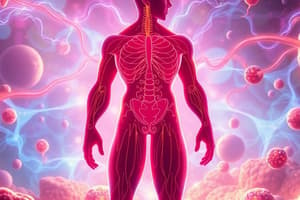Podcast
Questions and Answers
In carbohydrate catabolism, glucose is broken down into pyruvate through a process called proteolysis.
In carbohydrate catabolism, glucose is broken down into pyruvate through a process called proteolysis.
False (B)
Glycogen, starch and fructose are examples of how glucose is used for storage.
Glycogen, starch and fructose are examples of how glucose is used for storage.
False (B)
The net gain of ATP in glycolysis, after accounting for the ATP used in the initial activation steps, is 8 ATP molecules.
The net gain of ATP in glycolysis, after accounting for the ATP used in the initial activation steps, is 8 ATP molecules.
True (A)
Hexokinase catalyzes the conversion of fructose 6-phosphate to fructose 1,6-bisphosphate.
Hexokinase catalyzes the conversion of fructose 6-phosphate to fructose 1,6-bisphosphate.
The enzyme aldolase catalyzes the cleavage of fructose 1,6-bisphosphate into two 2-carbon molecules.
The enzyme aldolase catalyzes the cleavage of fructose 1,6-bisphosphate into two 2-carbon molecules.
Triose phosphate isomerase converts glyceraldehyde 3-phosphate into dihydroxyacetone phosphate.
Triose phosphate isomerase converts glyceraldehyde 3-phosphate into dihydroxyacetone phosphate.
The enzyme glyceraldehyde 3-phosphate dehydrogenase facilitates the reduction of $NAD^+$ to NADH.
The enzyme glyceraldehyde 3-phosphate dehydrogenase facilitates the reduction of $NAD^+$ to NADH.
Phosphoglycerate kinase catalyzes a substrate-level phosphorylation, where ATP is produced from ADP.
Phosphoglycerate kinase catalyzes a substrate-level phosphorylation, where ATP is produced from ADP.
Enolase promotes the elimination of water from 3-phosphoglycerate, leading to the formation of phosphoenolpyruvate.
Enolase promotes the elimination of water from 3-phosphoglycerate, leading to the formation of phosphoenolpyruvate.
Pyruvate kinase catalyzes the final substrate-level phosphorylation in glycolysis, producing ATP and pyruvate.
Pyruvate kinase catalyzes the final substrate-level phosphorylation in glycolysis, producing ATP and pyruvate.
The preparatory phase of glycolysis involves the consumption of 2 ATP molecules.
The preparatory phase of glycolysis involves the consumption of 2 ATP molecules.
The enzyme phosphohexose isomerase converts glucose 6-phosphate to fructose 6-phosphate and requires $Mg^{2+}$ for its activity.
The enzyme phosphohexose isomerase converts glucose 6-phosphate to fructose 6-phosphate and requires $Mg^{2+}$ for its activity.
The reaction catalyzed by aldolase has a significantly negative standard free-energy change in cells.
The reaction catalyzed by aldolase has a significantly negative standard free-energy change in cells.
The conversion of 1,3-bisphosphoglycerate to 3-phosphoglycerate is reversible under cellular conditions.
The conversion of 1,3-bisphosphoglycerate to 3-phosphoglycerate is reversible under cellular conditions.
The standard free-energy change for the reaction catalyzed by triose phosphate isomerase is close to zero, indicating it is near equilibrium in cells.
The standard free-energy change for the reaction catalyzed by triose phosphate isomerase is close to zero, indicating it is near equilibrium in cells.
In glycolysis, fructose 1,6-bisphosphate is directly converted into pyruvate without passing through 3-carbon intermediates.
In glycolysis, fructose 1,6-bisphosphate is directly converted into pyruvate without passing through 3-carbon intermediates.
The enzyme enolase functions to add a phosphate group to 2-phosphoglycerate, preparing it for the next ATP-generating step.
The enzyme enolase functions to add a phosphate group to 2-phosphoglycerate, preparing it for the next ATP-generating step.
The activity of phosphofructokinase-1 (PFK-1) is not affected by changes in ATP concentration.
The activity of phosphofructokinase-1 (PFK-1) is not affected by changes in ATP concentration.
The conversion of phosphoenolpyruvate to pyruvate by pyruvate kinase requires only $Mg^{2+}$ to proceed.
The conversion of phosphoenolpyruvate to pyruvate by pyruvate kinase requires only $Mg^{2+}$ to proceed.
The primary role of the pentose phosphate pathway is to produce ATP for cellular energy.
The primary role of the pentose phosphate pathway is to produce ATP for cellular energy.
Flashcards
What is Catabolism?
What is Catabolism?
The breakdown of complex molecules into simpler ones, often releasing energy.
What is Glycolysis?
What is Glycolysis?
A series of reactions that extract energy from glucose, yielding pyruvate.
What is the role of Glucose?
What is the role of Glucose?
The central molecule in carbohydrate metabolism, serving as fuel and a precursor for biosynthesis.
What is the Energy Investment Phase?
What is the Energy Investment Phase?
Signup and view all the flashcards
What is the Energy Payoff Phase?
What is the Energy Payoff Phase?
Signup and view all the flashcards
What is Reaction 1 of Glycolysis?
What is Reaction 1 of Glycolysis?
Signup and view all the flashcards
What is Hexokinase?
What is Hexokinase?
Signup and view all the flashcards
What is Reaction 2 of Glycolysis?
What is Reaction 2 of Glycolysis?
Signup and view all the flashcards
What is Phosphofructokinase-1 (PFK-1)?
What is Phosphofructokinase-1 (PFK-1)?
Signup and view all the flashcards
What is the Aldolase Reaction?
What is the Aldolase Reaction?
Signup and view all the flashcards
What is Triose Phosphate Isomerase?
What is Triose Phosphate Isomerase?
Signup and view all the flashcards
Study Notes
- Catabolism covers the breakdown of proteins into amino acids, fats into fatty acids, and carbohydrates into glucose.
- Protein catabolism, fatty acid oxidation, and glycolysis all produce Acetyl-CoA
- Acetyl-CoA then drives the Citric Acid Cycle and oxidative phosphorylation.
- Acetyl-CoA can also drive fatty acid synthesis.
Central Role of Glocuse
- Glucose is central in metabolism.
- Glucose can be stored in the form of glycogen, starch and sucrose.
- It is also essential for the syntheisis of structural polymers and extracellular matrix and cell wall polysaccharides.
- Glucose undergoes oxidation via the pentose phosphate pathway producing Ribose 5-phosphate.
- Glucose can also undergo oxidation via glycolysis yielding pyruvate.
Overview of Glycolysis
- Glycolysis (aerobic) requires 1 glucose molecule.
- It requires 2 ATP for activation.
- Glycolysis produces 2 pyruvate molecules and 4 ATP and 2 NADH, which equals 6 ATP.
- In total, glycolysis produces 10 ATP molecules: a net gain of 8 ATP (10-2=8).
Two Phases of Glycolysis
- There are two phases to glycolysis: the preparatory phase and the payoff phase.
- The preparatory phase involves the phosphorylation of glucose and its conversion to glyceraldehyde 3-phosphate.
- The payoff phase involves the oxidative conversion of glyceraldehyde 3-phosphate to pyruvate and the coupled formation of ATP and NADH.
10 Steps of Glycolysis
- Reaction 1 involves the phosphorylation of glucose to create glucose 6-phosphate; this step is catalyzed by hexokinase and has a ΔG'° = - 16.7 kJ/mol.
- Reaction 2 is an isomerization which turns glucose 6-phosphate into fructose 6-phosphate; this step is catalyzed by phosphohexose isomerase and has a ΔG'° = 1.7 kJ/mol.
- Reaction 3 is a phophorylation of fructose 6-phosphate to produce fructose 1,6-bisphosphate; this step is catalyzed by phosphofructokinase-1 (PFK-1) and has a ΔG'° = - 14.2 kJ/mol.
- Reaction 4 is a cleavage; fructose 1,6-bisphosphate is broken down to dihydroxyacetone phosphate and glyceraldehyde 3-phosphate; this step is catalyzed by aldolase and has a ΔG'° = 23.8 kJ/mol.
- Reaction 5 is an isomerization reaction that converts dihydroxyacetone phosphate into glyceraldehyde 3-phosphate using triose phosphate isomerase; this reaction has a ΔG'° = 7.5 kJ/mol.
- Reaction 6 is an oxidation, where glyceraldehyde 3-phosphate is converted to 1,3-bisphosphoglycerate with the help of glyceraldehyde 3-phosphate dehydrogenase; this has a ΔG'° = 6.3 kJ/mol.
- Reaction 7 involves substrate level phosphorylation, converting 1,3-bisphosphoglycerate to 3-phosphoglycerate via phosphoglycerate kinase, resulting in an ATP molecule and a ΔG'° = -18.5 kJ/mol.
- Reaction 8 involves a shift in the phosphoryl group: 3-phosphoglycerate is converted to 2-phosphoglycerate with the enzyme phosphoglycerate mutase, under Mg2+ conditions; and has a ΔG'° = 4.4 kJ/mol.
- Reaction 9 is a dehydration of 2-phosphoglycerate to phosphoenolpyruvate with the assistance of enolase; with a ΔG'° = 7.5 kJ/mol
- Reaction 10 is a substrate level phosphorylation reaction: phosphoenolpyruvate is converted to pyruvate with the enzyme pyruvate kinase, requiring Mg2+ and K+; and resulting in ATP and a ΔG'° = - 31.4 kJ/mol.
Studying That Suits You
Use AI to generate personalized quizzes and flashcards to suit your learning preferences.




